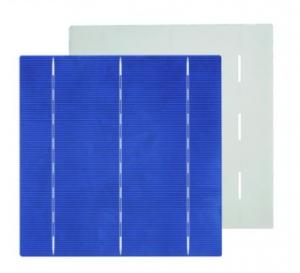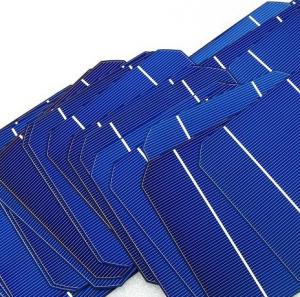Monocrystal Solar Energy Cell 156 156mm with 18.4 Efficiency
- Loading Port:
- China main port
- Payment Terms:
- TT or LC
- Min Order Qty:
- 10000 pc
- Supply Capability:
- 1000000 pc/month
OKorder Service Pledge
OKorder Financial Service
You Might Also Like
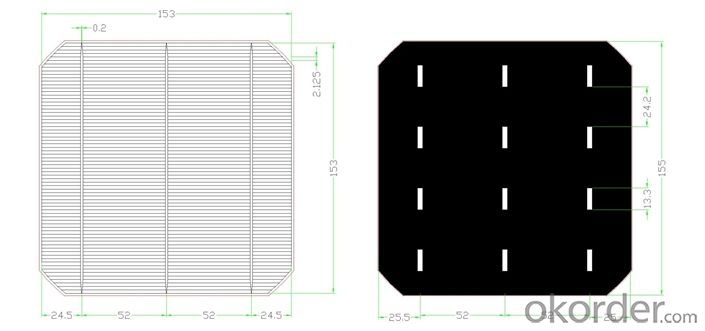
Monocrystal Solar Energy Cell
type:156M
appearance:156×1565㎜±0.5mm;diagonal:R=100mm
Main fence wide:1.4-1.5mm back electrode wide:2-2.5mm
Fence line qty:90
Cell thickness:220um±20um
Eff(%) | 18.00- 18.10 | 18.10- 18.20 | 18.20- 18.30 | 18.30- 18.40 | 18.40- 18.50 | 18.50- 18.60 | 18.60- 18.70 | 18.70- 18.80 | 18.80- 18.90 | 18.9- 19.0 | 19.1- 19.1 | 19.1- 19.2 |
Pm(W) | 4.30 | 4.33 | 4.35 | 4.37 | 4.40 | 4.42 | 4.44 | 4.47 | 4.49 | 4.52 | 4.54 | 4.56 |
Isc(A) | 8.71 | 8.73 | 8.76 | 8.77 | 8.78 | 8.82 | 8.83 | 8.85 | 8.86 | 8.88 | 8.9 | 8.93 |
Im(A) | 8.19 | 8.21 | 8.24 | 8.26 | 8.30 | 8.33 | 8.35 | 8.39 | 8.42 | 8.45 | 8.47 | 8.51 |
Voc(V) | 0.630 | 0.631 | 0.632 | 0.633 | 0.634 | 0.634 | 0.635 | 0.636 | 0.637 | 0.637 | 0.638 | 0.64 |
Vm(V) | 0.527 | 0.528 | 0.529 | 0.531 | 0.531 | 0.532 | 0.534 | 0.534 | 0.535 | 0.536 | 0.537 | 0.538 |
FF(%) | 78.6 | 78.7 | 78.8 | 79.0 | 79.2 | 79.3 | 79.5 | 79.6 | 79.8 | 80 | 80 | 80 |

remark:our company cells as per working current concentrate principle,separate the first and the second grade
Advantage of Polycrystalline Solar Cells
Tire-1 Solar Cells’ Manufacturer Quality Guarantee. With a complete and sophisticated quality government system, our Quality Management have arrived world’s leading place. Customer can receive Tire-1 Cells Maker’s Quality Standard Products.
Trusted Warranty. We can supply trusted after-sales service to our customer. If our cells are found not in conformity to the specification of manufacturer, or should the inspected quantity found in shortage, or should the packing found damaged, the buyer has the right to claim to the seller. The claim, if any, should be presented to seller within 30 days after cargo's arrival date to the port, together with related inspection report and photos issued and provided by a reputable independent surveyor such as SGS.
Factory Picture of Solar Cells
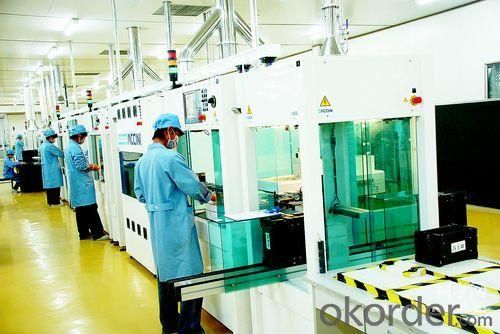
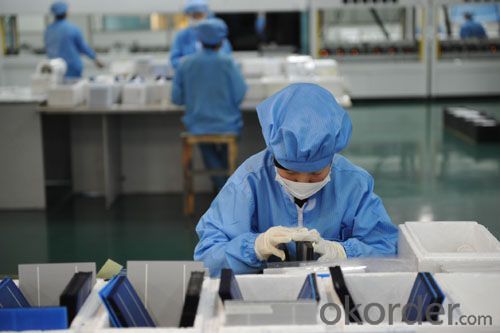
FAQ
We have organized several common questions for our clients,may help you sincerely:
What’s price per watt?
A: It’s depends on the quantity, delivery date and payment terms of the order. We can talk further about the detail price issue. Our products is high quality with lower price level.
Can you tell me the parameter of your solar cells?
We have different series of cells with different power output, both from c-si to a-si. Please take our specification sheet for your reference.
How do you pack your products?
We have rich experience on how to pack the panels to make sure the safety on shipment when it arrives at the destination.
Can you do OEM for us?
Yes, we can.
How long can we receive the product after purchase?
In the purchase of product within three working days, We will arrange the factory delivery as soon as possible. The perfect time of receiving is related to the state and position of customers. Commonly 7 to 10 working days can be served.
Solar cell power generation system and how its working
Solar panels, also known as modules, contain photovoltaic cells made from silicon that transform incoming sunlight into electricity rather than heat. Solar photovoltaic cells consist of a positive and a negative film of silicon placed under a thin slice of glass and they knock the electrons off the silicon. The negatively-charged free electrons are preferentially attracted to one side of the silicon cell, his current is gathered by wiring the individual solar panels together in series to form a solar photovoltaic array.
The inverter is typically located in an accessible location, as close as practical to the modules. In a residential application, the inverter is often mounted to the exterior sidewall of the home near the electrical main or sub panels. Since inverters make a slight noise, this should be taken into consideration when selecting the location.
In a solar electric system that is also tied to the utility grid, the DC power from the solar array is converted into 120/240 volt AC power and fed directly into the utility power distribution system of the building. The power is “net metered,” which means it reduces demand for power from the utility when the solar array is generating electricity – thus lowering the utility bill. These grid-tied systems automatically shut off if utility power goes offline, protecting workers from power being back fed into the grid during an outage. These types of solar-powered electric systems are known as “on grid” or “battery-less” and make up approximately 98% of the solar power systems being installed today..
- Q:What's the benefit of using a solar cell?
- It can be easily applied in suburban areas where there's only sunshine without much water.
- Q:What is the typical warranty for solar cells?
- The typical warranty for solar cells usually ranges from 10 to 25 years.
- Q:What is the role of grounding systems in solar cell systems?
- The role of grounding systems in solar cell systems is to provide a safe and efficient pathway for the dissipation of electrical faults and to protect the system from electrical surges and lightning strikes. Grounding systems help minimize the risk of electrical shock, equipment damage, and fire hazards by establishing a connection to the earth, allowing excess electrical energy to be safely redirected and dispersed.
- Q:How big are solar cells?
- Solar cells vary in size depending on their application. They can range from small cells measuring a few centimeters in width and length, commonly used in portable electronics, to larger panels that can be several meters in width and length, used in residential or commercial installations.
- Q:What is the expected degradation rate of a solar cell?
- The expected degradation rate of a solar cell can vary depending on various factors such as the quality of materials used, manufacturing processes, and operating conditions. On average, solar cells can experience a degradation rate of around 0.5-1% per year. However, with advancements in technology and better quality control measures, modern solar cells are designed to have lower degradation rates, often below 0.5% per year, ensuring their longevity and efficiency over time.
- Q:How do solar cells compare to fossil fuels in terms of energy production?
- Solar cells have several advantages over fossil fuels in terms of energy production. Firstly, solar cells harness renewable energy from the sun, while fossil fuels are non-renewable and finite resources. Secondly, solar cells produce clean energy, emitting no greenhouse gases or pollutants, whereas fossil fuels release harmful emissions that contribute to climate change and air pollution. Additionally, solar cells can be installed on rooftops or in remote areas, making energy production more decentralized and less reliant on centralized power plants. However, solar cells currently have limitations in terms of efficiency and storage capacity, which fossil fuels have a higher energy density and can provide continuous power supply. Overall, solar cells offer a sustainable and environmentally-friendly alternative to fossil fuels, but further advancements are needed to fully replace their energy production capabilities.
- Q:Can solar cells be used for powering schools?
- Yes, solar cells can be used to power schools. Solar energy is a renewable and sustainable source of power, and installing solar panels on school rooftops or grounds can generate electricity to meet the energy needs of schools. This can significantly reduce the reliance on fossil fuels and decrease carbon emissions, making it an environmentally friendly solution. Additionally, solar power can provide a reliable and consistent energy source, especially in sunny regions, ensuring schools have a stable power supply.
- Q:Can solar cells be used in industrial applications?
- Yes, solar cells can be used in industrial applications. They are increasingly being utilized in industries such as manufacturing, agriculture, and transportation to generate clean and sustainable energy. Solar cells are capable of powering large-scale operations, reducing reliance on traditional energy sources, and helping businesses reduce their carbon footprint.
- Q:How do solar cells perform in areas with high levels of radiation?
- Solar cells actually perform better in areas with high levels of radiation. The higher the radiation levels, the more energy they can absorb and convert into electricity. This is because solar cells rely on sunlight to generate electricity, and areas with high radiation levels receive more sunlight, resulting in increased energy production.
- Q:How many types of solar cells are now being used in real life?
- There are many different types depends on different materials.
1. Manufacturer Overview |
|
|---|---|
| Location | |
| Year Established | |
| Annual Output Value | |
| Main Markets | |
| Company Certifications | |
2. Manufacturer Certificates |
|
|---|---|
| a) Certification Name | |
| Range | |
| Reference | |
| Validity Period | |
3. Manufacturer Capability |
|
|---|---|
| a)Trade Capacity | |
| Nearest Port | |
| Export Percentage | |
| No.of Employees in Trade Department | |
| Language Spoken: | |
| b)Factory Information | |
| Factory Size: | |
| No. of Production Lines | |
| Contract Manufacturing | |
| Product Price Range | |
Send your message to us
Monocrystal Solar Energy Cell 156 156mm with 18.4 Efficiency
- Loading Port:
- China main port
- Payment Terms:
- TT or LC
- Min Order Qty:
- 10000 pc
- Supply Capability:
- 1000000 pc/month
OKorder Service Pledge
OKorder Financial Service
Similar products
New products
Hot products
Related keywords

